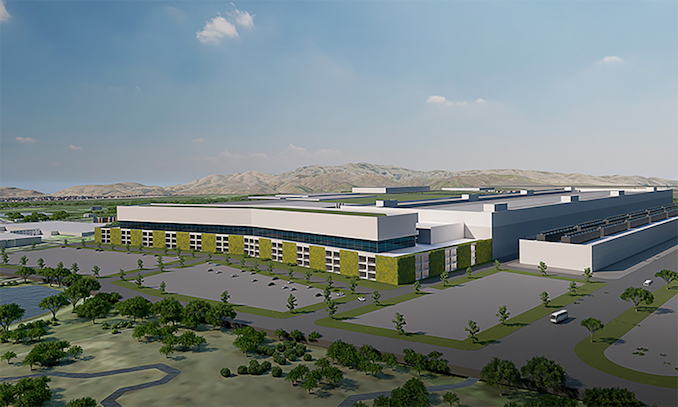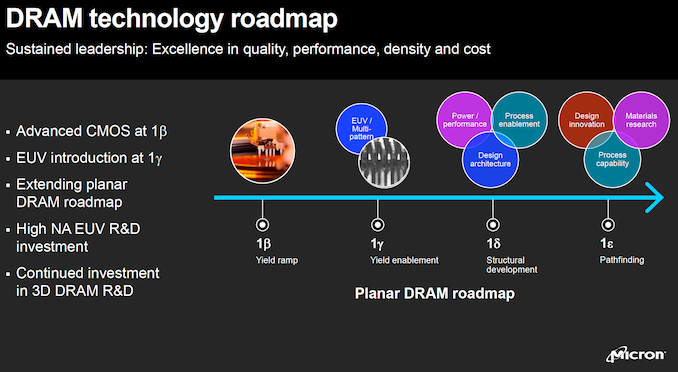Micron Breaks Ground on Its $15 Billion EUV DRAM Fab in the U.S.
by Anton Shilov on September 14, 2022 9:00 AM EST- Posted in
- Memory
- Micron
- DRAM
- Semiconductors
- EUV

Micron this week broke ground on its leading-edge memory production facility near Boise, Idaho. The company will invest $15 billion in its new fab as a part of its ambitious plan to invest $40 billion in its U.S.-based manufacturing capacities by the end of this decade as well as spend $150 billion on new fabs by 2030 globally.
Micron's upcoming leading-edge fab will produce DRAM and will be a rather colossal manufacturing facility. At build-out, when the fab is fully equipped with tools, its cleanroom space will reach 600,000 feet2 (55,700 meters2), which is about two times larger compared to cleanroom space at GlobalFoundries' Fab 8 and which is comparable to cleanroom space at giant fabs operated by Micron's rivals Samsung and SK Hynix is South Korea. Essentially, Micron will operate one of the largest semiconductor production facilities in the U.S.
The new fab will be located adjacent to Micron's R&D center and headquarters near Boise, Idaho, which will bring together scientists, process technology developers, and manufacturing engineers in one location, something that promises to speed up time-to-yield and time-to-market for advanced DRAMs.
"With this facility, Micron will closely couple R&D and manufacturing, providing synergies that will enable us to accelerate the production ramp of advanced memory technology," said Sanjay Mehrotra, president and CEO of Micron.
Micron is currently prepping the site for the new fab and plans to begin construction in early 2023 in a bid to start bringing cleanroom space online gradually starting in 2025. The facility will be equipped with modern deep ultraviolet (DUV) and extreme ultraviolet (EUV) lithography tools and will make memory using one of Micron's advanced EUV-enabled production nodes. The company intends to start fabbing DRAMs at its new facility sometimes in 2025 and then ramp up production to the full capacity in the following years.

At present it is hard to guess which fabrication process will be adopted at the new fab. Considering the fact that Micron is expected to start DRAM production using its first EUV-enabled manufacturing technology (1γ) sometimes in mid-2023 – early-2024, it is likely that the fab near Boise, Idaho, will adopt the company's second EUV-enabled process (1δ). Yet, this is an educated guess (based on habitual introduction of new DRAM nodes every 18 months or so) at this point.
Micron intends to make 40% of its global DRAM output in America in 2030s, a rebalance that the company has not done in decades. Therefore, in addition to Micron's new fab near Boise, Idaho, the company plans to build a yet another DRAM facility in the U.S. Currently the company is in the final stages of its selection process for another site in America.
Micron will invest $15 billion in the new manufacturing facility near Boise, Idaho. The company also plans to get incentives from the local and state authorities and support from the federal government enabled by the CHIPS and Science act signed into law last month.
"The investment, made possible by the anticipated grants and credits provided by the CHIPS and Science Act, also enhances Micron's supply chain resilience and will establish a new strategic capability for the U.S.," said the head of Micron.
It is noteworthy that Micron is not the only DRAM maker to start building new memory fabs when demand for both 3D NAND and DRAM is down. Last week SK Hynix began to expand its M15 site with its new M15X building as the company is preparing for increased DRAM demand starting in 2025.
Source: Micron










23 Comments
View All Comments
Samus - Wednesday, September 14, 2022 - link
Not everyone has a Delorean to know the future.As far as water and fabs go, they don't need much water. No more than any other industrial complex that size. They recycle almost everything they use, inherent by design due to the strict filtering requirements. They rarely start with naturally sourced water from a river, etc, like a NPP would. TSMC recycles 99% of their fab water for reuse. Basically what they start with during a wafer cycle is what they will use again after purification on the next cycle.
quorm - Wednesday, September 14, 2022 - link
It's not quite that high. Tsmc is closer to high 80's % process water recycling. This is in Taiwan, though, and I'm not sure if the specialized water recycling facilities will be built in the US.Samus - Wednesday, September 14, 2022 - link
The following PR backs up your "high 80's" comment with results of 86.7% in 2019. However, they opened the Tainan Science Park Reclaimed Water Plant last year which at the moment recycles "over 90% of water to industrial purity" and "the plant's total water demand of 118,000m 3/d will be fully supplied by reclaimed water by 2028" or in other words, 100% reclaimed water and 0% dependent on municipal water supply in the next 5 years.It can only be assumed (and hoped for) that plants being built now, from scratch, with the momentum of climate change, will have similar facilities. After all, TSMC retrofitted a 2 decade-old site with this capability - it would be embarrassing for brand new kit to lack similar function.
https://esg.tsmc.com/en/focus/greenManufacturing/w...
quorm - Thursday, September 15, 2022 - link
That's going to depend on the economics. TW is different from the us in terms of functioning govt and climate. The climate is much, much drier at most of these new US sites (vs. normal Taiwan weather), so it would make sense to conserve water, but if they got a guarantee of water rights/priority from the local gov., they may just save money and skip conservation.FreckledTrout - Friday, September 16, 2022 - link
I have not seen any mandates from the US on water recycling albeit I bet that will follow along once enough fab capacity is rolled out.Oxford Guy - Friday, September 16, 2022 - link
Do they heat the water that goes into the rivers or other bodies? That is one of the issues related to factories and water use. It's not just the amount of water that disappears; it's also how much it is heated and thus makes habitats unlivable for various parts of the food chain.I am not, at all, an expert in fabs' water use. This is just a question.
Papaspud - Friday, September 16, 2022 - link
The factory will be using groundwater, it isn't close to any body of open water- I used to drive by there every day- that place is already huge.quorm - Saturday, September 17, 2022 - link
Well, if they have their own wells, it's much harder to track how much they are using.According to Micron's PR, they recycle about 70% of their water. I doubt that they will increase that % to tsmc levels.
Samus - Wednesday, September 21, 2022 - link
Oxford, afaik the waste water from these facilities is ambient temp, and likely cleaner than it came in. It just has different minerals\components that the incoming water might not have, such as too many oxygen molecules that are more time consuming to filter out than incoming water that is less oxygenated but has other components that filter easier.The ejected water may have chemical trace elements that need to be processed out before legally disposing of it. This is actually why plants recycle water as much as possible: its cheaper than cleaning the water to refuse regulations.
Oxford Guy - Friday, September 16, 2022 - link
Getting things wrong for the public-facing messaging is part of the business.